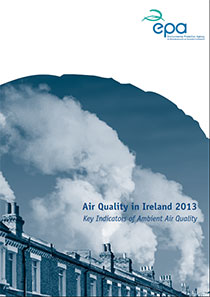Air Quality in Ireland 2013
Key Indicators of Ambient Air Quality.
Summary: Ambient air quality trends based on concentration measurements in 2013 of particulate matter, sulphur dioxide, nitrogen oxides, black smoke, heavy metals, ozone, polycyclic aromatic hydrocarbons, carbon monoxide and benzene.

Executive Summary
This report provides an overview of air quality in Ireland for 2013, based on data obtained from the 29 monitoring stations that form the National Ambient Air Quality Network, including data from a number of mobile air quality monitoring units. Monitoring stations are located across the country, with new stations added in 2013 at Davitt Road, Dublin, St. Anne’s Park in Dublin and Finglas in Dublin. Also a previous monitoring station at Ballyfermot, Dublin reopened after refurbishment of the site. The monitoring site at Old Station Road in Cork also moved to a new location at the South Link Road, Cork.
The results of the monitoring are compared to limit values set out in EU and Irish legislation on ambient air quality. Overall, air quality in Ireland compares favourably with other EU Member States. Measured values of sulphur dioxide (SO2), nitrogen dioxide (NO2), carbon monoxide (CO), Ozone (O3), particulate matter (PM10 and PM2.5), heavy metals, benzene and polycyclic aromatic hydrocarbons (PAH) were all below limit and target values set out in the CAFE Directive and 4th Daughter Directive. However, when some of these parameters are compared to the tighter WHO Air Quality Guideline values, it highlights some potential issues. Ireland is above these guideline values with respect to PM10, PM2.5, ozone and PAH. This may have important implications for Ireland in the future, if these WHO guideline values are adopted as limit values by the EU, which may occur following the European Commission’s review on the air quality Directives. This move would be supported by calls made recently in the 7th Environmental Action Programme.
This report for the first time has incorporated the EPA dioxins study as a chapter. The study found in 2013 that dioxin levels recorded in the survey compare favourably with those from previous surveys and from other EU countries. This report also introduces some aspects of research undertaken on behalf of the EPA, with relevance to air quality – including projects on air quality modelling, developing an emissions inventory for Ireland, particulate matter composition and an evaluation of the effect of home heating on air quality in Ireland.
The EPA Licensing and Enforcement aspects of Air Quality are introduced in this report, including a summary of the emissions monitoring undertaken in 2013. The National Ambient Air Quality Network also contributed data to the assessment of the impact on air quality of the fire which occurred over the period Saturday January 25th to Wednesday January 29th at the Oxigen facility in Ballymount, Dublin. Overall the results of the air quality monitoring undertaken indicated that the air quality impact of the fire was localised and transient, and there was no significant potential for any long-term health or environmental impacts as a result of this incident.
https://www.epa.ie/media/epa-2020/compliance-amp-enforcement/air/air_quality_dlc.jpg